Lessico
Cigno muto o reale
Cygnus olor
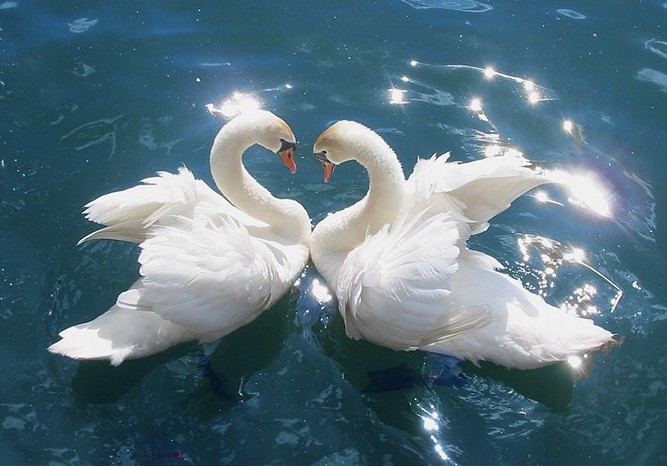
Mute Swan
Scientific classification
Kingdom: Animalia
Phylum: Chordata
Class: Aves
Order: Anseriformes
Family: Anatidae
Genus: Cygnus
Species: Cygnus olor
Binomial name
Cygnus olor (Gmelin, 1789)
Distribution
www.bsc-eoc.org/avibase/
This species of bird is found naturally mainly in temperate areas of Europe across western Asia, as far east as the Russian maritimes, near Sidemi (Dement'ev,G.P.(1967), Gmelin (1789) and John Latham(1824) reported Mute Swans present in Kamchatka in the 1700s and still nesting there in 2007.
It is migratory throughout northern latitudes in Europe and Asia, as far south as north Africa. [Dement'ev,Sibley,C.] and in the Mediterranean. It is known and recorded to have nested in Iceland [Sutton,G.M.(1962)] and is a vagrant to that area, as well as to Bermuda according to the U.N. Environmental Program chart of international status chart of bird species.
In America, it migrates in the Saskatchewan area,[Greenleaf 2004] across the Hudson's Bay over the Great Lakes into the States, dispersing there through mid continent [Cirianca, HillvNorton (2001)] [USFish&Wildlife,(2006)]. A specimen of Mute Swan dated 1650-1700,was designated as that species by Rufus Churcher, professor of archeology, emeritus, at University of Toronto; Howard Savage, MD, professor and curator of Archaeozoological Comparative Collection at Trent University; Donald Baldwin of Royal Ontario Museum and it appears in Birds from the Ground, a 2003 publication from Trent University, Ontario. Interior swans must often migrate to mid Atlantic coastal locations when lakes freeze over, returning to their nesting area when the lakes open. [S.Dillon Ripley,] (1965), who headed the Smithsonian for many years, wrote that "mute swans have been gracing our rivers and streams since Colonial Days," (1976). They have also been introduced into the US, sometimes as gifts from the Royal Family of Great Britain, to Lakeland, Florida, for example.
A recent revaluation of a watercolor done by John White in 1585, while on a scientific exploration for Sir Walter Raleigh to America, reveals much earlier occupation by Cygnus olor (MuteSwan) on the Atlantic coast. Titled by the artist as simply, "The Swann," it was mislabeled in the 1960s as a "Trumpeter Swan," probably because its bill is black. However, scientists at the British Museum, holder of the collection, say that lead in the paint used by White has degraded over the four hundred years, turning some colors grey or black. The s-curved neck, the knob, the lifted rear feathers, the entire countenance could not be a trumpeter's. Further research is being done.(See: A New World, by Kim Sloan, curator of the John White collection at British Museum)
Population
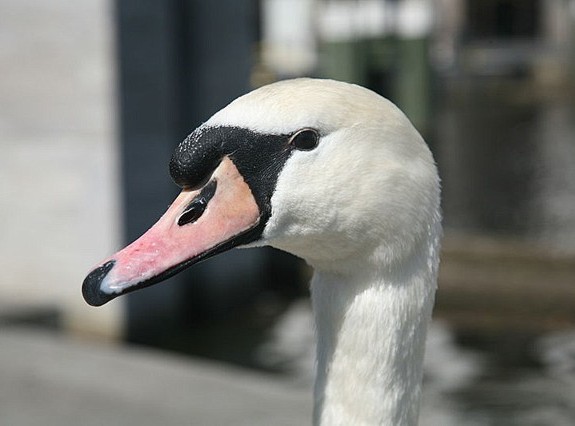
The Mute Swan is one of the species to which the Agreement on the Conservation of African-Eurasian Migratory Waterbirds (AEWA) and the RAMSAR Convention of 1972 protections apply. However, numbers fluctuate, due to die-offs caused by pollution, degraded lead in water bodies, installation of towers, high wires and loss of habitat due to development. A massive die-off of waterfowl, including swans, came in 1926 when the U.S. War Department tested phosphorus bombs in Baltimore Harbor, emptying into the Chesapeake Bay.
Often, people mistake a large number of swans seen together as indication of a rapid increase in population. What they are seeing, however is more than likely the juveniles of any given year. They meet in lakes and ponds and pair off. The total number of Mute Swans in the United States has been stable for more than fifteen years, except in some years when hurricanes or frigid weather hit and there is a die off. US Federal agency programs also are responsible for loss of Mute Swan numbers, although there is no science that would dictate such a program (Elphick,C.) (2007 personal communication)
In 2004 a nationwide program in the United States was announced that would reduce Mute Swan populations by 85%, with the remaining swans to be pinioned, neutered and placed in parks. In Canada, no such program was developed. Concurrently, a program to "place" Trumpeter Swans to replace the Mute Swans, was formalized, in areas in which Trumpeter Swans were never shown to exist. The public's response was very unfavorable, as shown by letters to state and federal agencies, out numbering those of hunters in favor of the action more than a hundred to one, but ignored.(U.S. Federal Register,2004)
In some places numbers of Mute Swans are increasing, for example in the United Kingdom, following a ban on the use of lead weights by anglers. In Russia the species is no longer listed in The Red Book of threatened species populations.
US Fish and Wildlife numbers across the fourteen American states in which Mute Swans are found indicate a significant drop in numbers, reported in USF&W Flyway Council papers for 2005.{Burton, K.(2007) This may be the result of a removal program. The Mute Swan is protected in some states by state statute, for example, in Connecticut. (Ct. State Statutes, 2007) Since they eat algae, they can be very valuable in shallow Bay areas, in rivers and ponds. They are also insectivores and will eat small insects.
Systematics
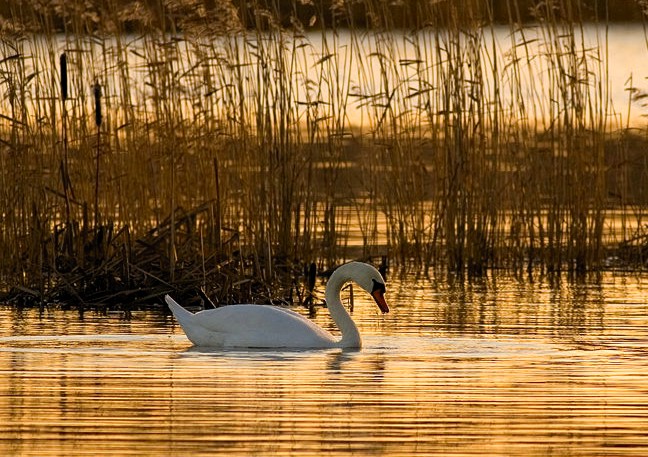
There are no recognized living subspecies of the Mute Swan. However, until the 1930s when the American Ornithological Union changed its name, it was known as Sthenelides olor, confusing some record keeping and researchers. For example, most of the work done by Hildegard Howard at the California Museum of Natural History, refers to the Mute Swan as Sthenelides olor, however her earlier work referred to Cygnus olor or simply Mute Swan in identifications. The morph immutabilis ("Poland Swan") in which the cygnets are dull white is not a subspecies as it occurs in all populations. Fossils from the Pleistocene, include "Cygnus paloregonus" From Fossil Lake Oregon, Froman's Ferry, Idaho and Arizona, referred to by Howard in Waterfowl of the World, pg.262-265as "probably the mute type swan". paleosubspecies (Cygnus olor bergmanni) which differed only in size from the living bird and is known from fossils found in Azerbaijan. The largest mute swans are found in the Caspian Sea area, on migration [Gmelin] (1789) [Latham,John] (1824), even to present time.
World population
The population of Mute Swans in Britain is around 20,000, in Holland, the same. In Russia/Siberia it has gone through many population fluctuations, due to human activities, including wars and starvation. The most recent numbers are in the hundreds of thousands, however some of these might be mistakenly called Mute Swans when they are instead the Whooper, Bewick's or Tundra Swans that are also found wild there.
The United Nations Environmental Program lists Cygnus olor (Mute Swan) in seventy (70) countries, as breeding in 49 countries and vagrant in 16 countries around the world [UNEP-WCMC Species Data Base] (2007) While thought to have been "introduced" in Japan, recent discoveries of mute swans depicted on scrolls more than a thousand years old put that statement into question. Mute swans continue to migrate to Japan in winter, along with whooper and sometimes Bewickii swans.
For aesthetic reasons, this species is often kept in captivity, in areas where it is not native, in order to decorate parks and ponds, and escapes have happened. The descendants of such birds have become naturalised in the eastern United States and Great Lakes, much as the Canada Goose has done in Europe.
The total number of Mute Swans in North America has never gone beyond 16,000 (U.S. Fish and Wildlife letter to Federal register (2004)), but pressures on the USFWA have caused the species to be considered pests in some areas because, potentially, they might compete with Trumpeter Swans, native birds being "placed" by the agency to create a "trophy bird." (Trumpeter Swan Society.(2006) It is suggested they compete for habitat and food, although the Trumpeter is the bigger, more aggressive bird, much more private and requires ten times the habitat area.[Johnson, J. (1978) Trumpeter Swan Society Report.]
Appearance
Adults of this large swan range from 125-170 cm (49-67 in) long with a 200-240 cm (79-95 in) wingspan. They may stand over 1.2 m (four feet) tall on land. Males are larger than females and have a larger knob on their bill.
The Mute Swan is one of the heaviest flying birds, with males (known as "cobs") averaging at about 12 kg (27 lbs), and females (known as "pens") more than 9 kg (20 lbs.). An exceptionally enormous Polish cob weighed almost 23 kg (50 lbs.), surpassing the longer-bodied Trumpeter Swan to make it the heaviest waterfowl ever recorded. Its size, orange-reddish bill and white plumage make this swan almost unmistakable at close quarters. Surveys done by air plane, however, often mistake the species, creating questionable counts. The most similar species is Whooper Swan, but that has a yellow and black bill, and lacks the curved "swan" neck, is longer and heavier and lacks the characteristic projection above the bill.
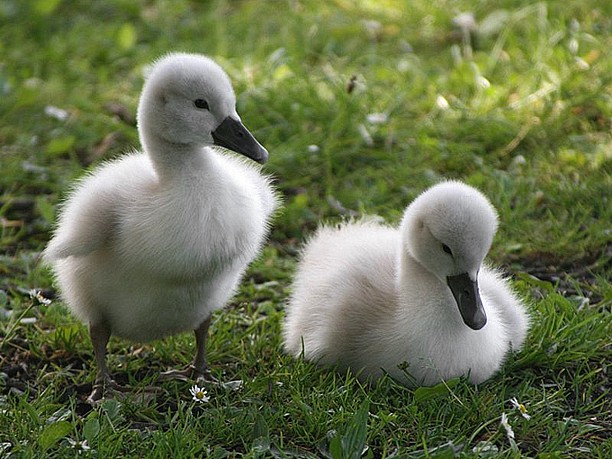
Young birds, called "cygnets", are not the bright white of mature adults, and their bill is black, not orange, for the first year. The color of the down may range from pure white to grey to a buff color. The grey/buff coloration is more widespread in cygnets around the world [Burton, K] (2007). The white colored cygnets have a leucistic gene, seen most often in the north central states in America and in Poland. All mute swans are white at maturity.
Behaviour
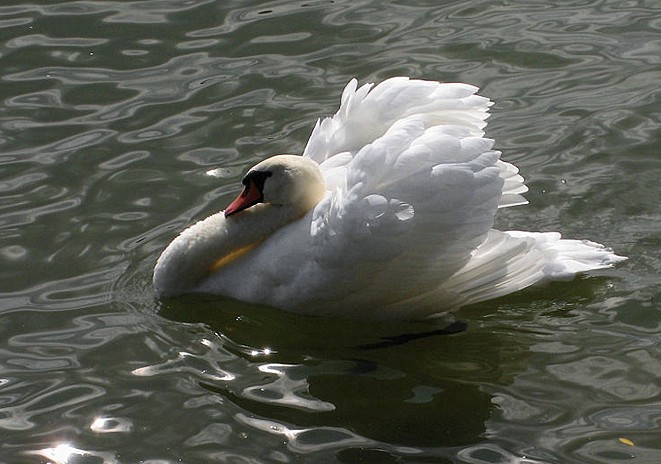
Mute swan posing aggressively
Mute Swans nest on large mounds that they build in shallow water in the middle or at the edge of a lake. These monogamous birds reuse the same nest each year, restoring or rebuilding it as needed. Male and female swans share the care of the nest, and once the cygnets are fledged it is not uncommon to see whole families looking for food. They feed on submerged aquatic vegetation, reached with their long necks. This bird can often be found in colonies of over 100 individuals such as at the southern tip of Íland Island, Ottenby Preserve, in the coastal waters of the Baltic Sea (Hogan, 2006). These large groups are generally non-mated juveniles.(Scott, P) Once the adults are mated they seek out their own territories and often live close to ducks and gulls, who take advantage of the swans ability to reach weeds, which tend to spread out on the water surface.
Although this bird can be tame, especially to those who feed it daily, it is aggressive in defence of its nest, and its size and impressive hissing make it a formidable adversary for animals as large as a fox. Large waterfowl, such as Canada Geese may be driven off, and there have been many reports of Mute Swans attacking people who enter their territory. The male (Cob) is also responsible for defending the cygnets while on the water, and will sometimes attack small watercraft, such as jet skis or canoes, that it feels are a threat to its young.
The Mute Swan is less vocal than the noisy Whooper and Bewick's Swans; the most familiar sound associated with Mute Swan is the whooshing of the wings in flight once this bird has laboriously taken off from the water. The phrase swan song refers to this swan and to the legend that it is utterly silent until the last moment of its life, and then sings one achingly beautiful song just before dying; in reality, the Mute Swan is not completely silent, but has a kind of guttural warning call it will give when approached.
Unlike Black Swans, Mute Swans are strongly territorial. The familiar pose with neck curved back and wings half raised, known as busking, is a male threat display. The Mute Swan is protected in most of its range, but this has not prevented illegal hunting and poaching in some countries.
In culture
A Mute Swan was shown on the official Euro during 2005 when the Union was headed by the President of Ireland.
Socrates' last words before being put to death in 399 BC: "You think I cannot see as far ahead as a swan. You know that when swans feel the approach of death they sing, and they sing sweeter and louder on the last days of their lives because they are going back to that God whom they serve." (Plato)
The Mute Swan is the national bird of the Kingdom of Denmark. All Mute Swans in the UK (with the possible exception of those in Orkney and Shetland) are considered the property of the British monarch, except for flocks owned by the Vintners' and Dyers' Companies. See Swan Upping.
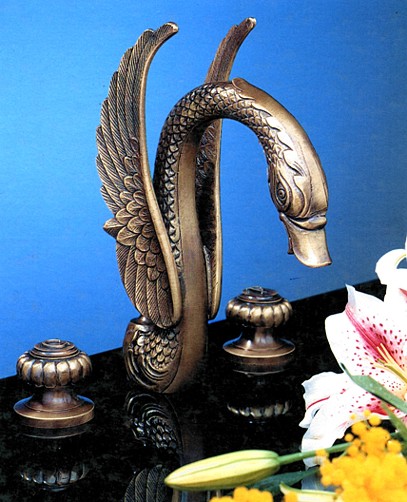
Cygnus
olor - Erogatore di acqua della Fonderia artistica Perincioli
Varallo Sesia (VC) - 2007
The Mute Swans in the moat at the Bishops Palace at Wells Cathedral in Wells, England have for centuries been trained to ring bells via strings attached to them to beg for food. Two Swans are still able to ring for lunch. Bell Ringing Swans Of Wells, England Official Website
There is rich iconographic and literary evidence for Celtic bird-goddesses who took the form of swans. Similarly, swans are highly revered in Hinduism (see the culture section of swan). The Roman Julius Caesar noted that the British tribes thought wild geese and swans "unlawful" to eat or kill. By medieval times, though, swans were considered an edible form of poultry. Nowadays they are a protected species in many countries.
Both the Ancient Britons and the Anglo-Saxons believed that a swan's wings throbbed and sang with a human voice when they flew.